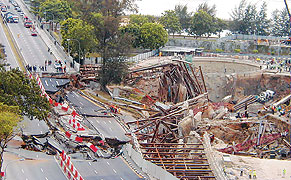Preparations are beginning for a formal inquiry into the April 20 collapse of a Singapore mass-transit tunnel excavation in which four workers were killed. For the record, all parties on the project are limiting their comments to bland disclaimers, if they are commenting at all. But knowledgeable sources are pointing to price competition engendered by the design-build project delivery as a contributing factor in the accident.
Nine parties are scheduled to testify at a May 14 conference to be held by the Singapore governments commission of inquiry. Formal proceedings are to start
June 1.
 |
| SHAFT SITE Excavation next to circular shaft collapsed when bracing panels failed. (Photo courtesy of Singapore LTA) |
A section of the temporary diaphragm wall supporting the excavation adjoining the proposed Nicoll Highway Station collapsed, says Ho Meng Kit, chief executive of the owner, the Land Transport Authority. This caused soil subsidence of the immediate surrounding area that resulted in substantial damage to about a 100-m section of Nicoll Highway. In addition to causing the deaths of three construction workers and an inspector, the collapse also rendered two buildings unsafe.
The design was extremely aggressive to the point that it took almost a year to approve, says a knowledgeable source, who asks to remain anonymous. To win the design-build contract, everybody was trying to shave as much as possible in the cost to be more competitive. Three or four groups competed for the work, and other designs were more substantial than the one that won, he says.
As for the design and methods of construction, they were approved by the LTA, counters Philip Khoo, Singapore-based deputy project manager of Nishimatsu Construction Co. The project contract is held by a joint venture of Tokyo-based Nishimatsu and Singapore-based Lum Chang Building Contractors. Maunsell Consulting Co., an Australia-based unit of AECOM, Los Angeles, is the projects permanent design engineer.
|
The collapse occurred in a cut-and-cover tunnel excavation for the Nicoll Highway station on the island nations 33-km-long Circle Line where four tracks, stacked two over two, widen onto a single level and begin to dip below the Kalang River. A circular shaft for lowering a tunnel-boring machine is adjacent to the site of the collapse.
The work began in 2001 and is part of a $158-million contract by the design-build joint venture to construct two stations, 1,600 m of cut-and-cover tunnels and 800 m of bored tunnels. Completion of this stage of the line was scheduled for 2007. LTA has declined to estimate the impact on cost and schedule until the investigation is completed.
The excavations design depth is 33 m, with 10 levels of bracing. At the bottom, two levels of jet grouting were installed. The first, 1.5 m thick, was a sacrificial one between the 9th and 10th brace. The other, 1.5 m thick, tapering towards one side to nothing, was below the bottom of the excavation.
The collapse occurred while workers were excavating at about 30 m for the 10th level of strut. An 800-mm slurry-wall retention system, without a capping beam and with a waler at the top and none in the lower levels, failed. Each slurry-wall panel was supported with a single brace. Consequently, when the bracing failed, the slurry-wall panels were acting individually and, like domino pieces, fell one-by-one, says one source.
Monitoring of wall movements suggested that design parameters were exceeded well before failure occurred. Monitoring data are not available, but sources report that wall deformations of 450 mm were observed before the collapse. Owners of nearby...

Post a comment to this article
Report Abusive Comment